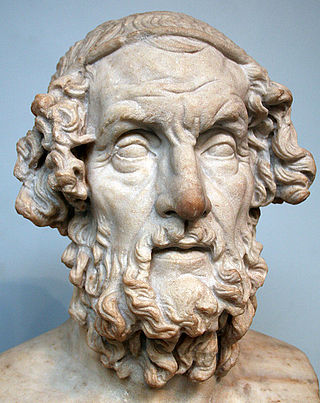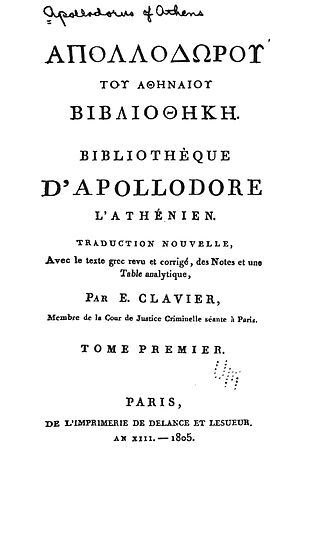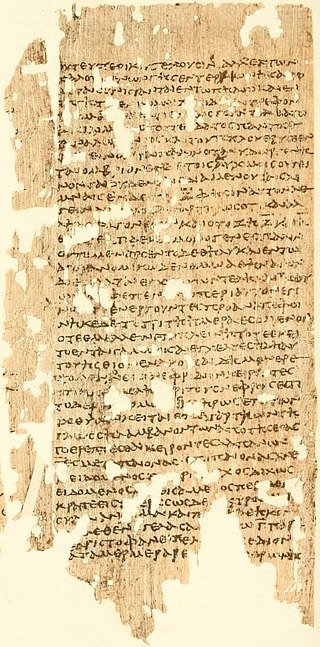Dionysius Thrax was a Greek grammarian and a pupil of Aristarchus of Samothrace. He was long considered to be the author of the earliest grammatical text on the Greek language, one that was used as a standard manual for perhaps some 1,500 years, and which was until recently regarded as the groundwork of the entire Western grammatical tradition.

Homer was an Ancient Greek poet who is credited as the author of the Iliad and the Odyssey, two epic poems that are foundational works of ancient Greek literature. Homer is considered one of the most revered and influential authors in history.
Didymus Chalcenterus was an Ancient Greek scholar and grammarian who flourished in the time of Cicero and Augustus.

The Bibliotheca, also known as the Bibliotheca of Pseudo-Apollodorus, is a compendium of Greek myths and heroic legends, genealogical tables and histories arranged in three books, generally dated to the first or second century CE. The author was traditionally thought to be Apollodorus of Athens, but that attribution is now regarded as false. As a result, "Pseudo-" has been affixed to Apollodorus.

Jean-Baptiste-Gaspard d'Anssede Villoison was a classical scholar born at Corbeil-sur-Seine, France.

The Epic Cycle was a collection of Ancient Greek epic poems, composed in dactylic hexameter and related to the story of the Trojan War, including the Cypria, the Aethiopis, the so-called Little Iliad, the Iliupersis, the Nostoi, and the Telegony. Scholars sometimes include the two Homeric epics, the Iliad and the Odyssey, among the poems of the Epic Cycle, but the term is more often used to specify the non-Homeric poems as distinct from the Homeric ones.

Aristarchus of Samothrace was an ancient Greek grammarian, noted as the most influential of all scholars of Homeric poetry. He was the head librarian of the Library of Alexandria and seems to have succeeded his teacher Aristophanes of Byzantium in that role.
Aelius Herodianus or Herodian was a Greek historian and one of the most celebrated grammarians of Greco-Roman antiquity. He is usually known as Herodian except when there is a danger of confusion with the historian also named Herodian.
Scholia are grammatical, critical, or explanatory comments – original or copied from prior commentaries – which are inserted in the margin of the manuscript of ancient authors, as glosses. One who writes scholia is a scholiast. The earliest attested use of the word dates to the 1st century BC.
Michael Panaretos was an official of the Trapezuntine empire and a Greek historian. His sole surviving work is a chronicle of the Trapezuntine empire of Alexios I Komnenos and his successors. This chronicle not only provides a chronological framework for this medieval empire, it also contains much valuable material on the early history of the Ottoman Turks from a Byzantine perspective, however it was almost unknown until Jakob Philipp Fallmerayer discovered it in the nineteenth century among the manuscripts of the Biblioteca Marciana of Venice. "Owing to this drab but truthful chronicle," writes the Russian Byzantist Alexander Alexandrovich Vasiliev, "it has become possible to a certain extent to restore the chronological sequence of the most important events in the history of Trebizond. This Chronicle covers the period from 1204 to 1426 and gives several names of emperors formerly unknown."
Aristonicus of Alexandria was a distinguished Greek grammarian who lived during the reigns of Augustus and Tiberius, contemporary with Strabo. He taught at Rome, and wrote commentaries and grammatical treatises.

Homeric scholarship is the study of any Homeric topic, especially the two large surviving epics, the Iliad and Odyssey. It is currently part of the academic discipline of classical studies. The subject is one of the oldest in education.

Eustathius of Thessalonica was a Byzantine Greek scholar and Archbishop of Thessalonica and is a saint in the Eastern Orthodox Church. He is most noted for his stand against the sack of Thessalonica by the Normans in 1185, contemporary account of the event, for his orations and for his commentaries on Homer, which incorporate many remarks by much earlier researchers.

In Greek mythology, Nilus is one of the three thousand Potamoi, the river gods, who represent the god of the Nile river itself. Nilus is the son of the water gods Oceanus and Tethys.

The Marciana Library or Library of Saint Mark is a public library in Venice, Italy. It is one of the earliest surviving public libraries and repositories for manuscripts in Italy and holds one of the world's most significant collections of classical texts. It is named after St Mark, the patron saint of the city.
Nicanor Stigmatias was a celebrated grammarian, who lived during the reign of the Roman emperor Hadrian in the early 2nd century AD.
In Greek mythology, the name Polymela or Polymele may refer to the following figures:

Papyrus Oxyrhynchus 221 contains Homeric scholia by an unknown author, written in Greek. It was discovered in Oxyrhynchus, Egypt. The manuscript was written on papyrus in the form of a roll. It is dated to the second century. Frederic G. Kenyon dated it to the first century or the first half of the second century. Currently it is housed in the British Library in London.
Casey Dué Hackney, sometimes cited or referred to as Casey Dué, is a professor of classical studies at the University of Houston, and the Executive Editor for the Center for Hellenic Studies. Her research interests centre around Homeric poetry, Greek tragedy and Greek oral traditions.

The collection of the Marciana Library contains 4,639 manuscripts and 13,117 manuscript volumes. Its historical nucleus is the private collection of Cardinal Bessarion, which was donated to the Republic of Venice in 1468.











